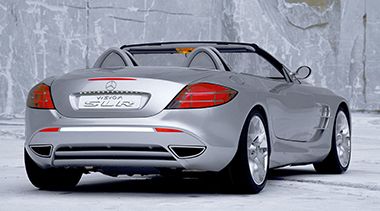Details of the Vision SLR
the Formula 1 racing car in which Mika Häkkinen had become 1998 World Champion served as the inspiration for the prominent front end with its arrow-shaped nose and characteristic twin fins, the formal concept of which was repeated at various points on the body and in the interior. This Formula 1 look harmonised with the familiar twin-headlamp design, which found an unusual reinterpretation in the Vision SLR.
The stylistic concepts of the iconic SL models of the 1950s and their SLR racing variants, which had swept Juan Manuel Fangio, Karl Klink and Stirling Moss from victory to victory, served as the basis for the stretched bonnet, powerfully curved wings and gullwing doors of the Vision SLR.
The interior of the concept vehicle was dominated by the wide, gently curved centre console with its circular controls as well as by the silver-painted wing profiles in front of driver and front passenger. These features replaced a conventional instrument panel while at the same time symbolising the state-of-the-art lightweight construction of the grand tourer. The cockpit consisted of two aluminium-bezelled round dials evocative of high-grade chronometers.
Carbon fibre bucket seats, an oval steering wheel and state-of-the-art information technology, such as the Cockpit Management and Data System (COMAND), were among the other technical features of the sporty interior.



